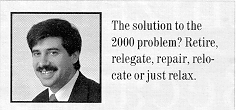 |
California Educational Data Processing Association
|
The DataBus - Vol. 36, No. 2
February-March, 1996
|
Dateline 1999: IS pros retire in droves
Michael Cohn
Alarmed about the year 2000? Worried about the YY date fields showing up as 00? Afraid to ask the chief financial officer for somewhere between $2 million to fix the two-digit year problem?
We in the IS field know the truth. The danger that date-critical calculations will go haywire is real, it's cataclysmic, and we're toast. Everything from legacy to LAN may be flat on its back. But you can't expect most folks to appreciate the impact of something that is more than four years away. Heck, my dry cleaner has trouble looking beyond next Tuesday.
So don't lose sleep or hair over the 2000 problem; there are a bunch of ways out of this mess. Show no remorse, have no regrets and choose your strategy from the list below.
- Retire. Get out of the business and make it someone else's problem. This may be the most common solution: IS executives will bail out in droves. Come the third quarter of 1999, the world will be devoid of IS managers--and just in time for us to finally get something done.
- Relegate. Another popular option is to assign the problem to someone else. Bury it within the ranks. Suck in some subordinate. Or, better yet, impose it on an innocent contract programmer. "Hey, Stan, want to make $24 an hour? Our 30 million lines of date-infected code should keep you busy for a while--especially since we can't even find half of it."
- Resign. Face it, when the folks upstairs find out how bad the problem is, you'll get the ax anyway. So have a little pride. Hold your head high, walk up to the CEO and unflinchingly insist you're leaving, even though the date thing is not your fault and you've put in the best 19 years of your life as the director of IS. To which he or she will likely reflect, take a deep breath, look down on you and say, "Tell me...who are you again?"
-
Re-engineer. Get rid of all your old software. Install a bunch of new stuff. How tough could that be, converting about 17,000 assembler programs? Let's see, at three a week, not counting Christmas, you could probably do it in...well...see option 3.

- Repair. OK, be brave and make the fix. But why stop at YYYY? Go five-digit! That'll hold for another 98,000 years. It may seem extreme, but I'm fairly sure our office furniture has been around that long, not to mention Mrs. McGillicuddy in Accounting.
- Recycle. If we have to do a bunch of date conversions anyway, I say let's start all over. Set the calendar to begin at Bill Gates' date of birth and make that 0 A.G. (After Gates). Of course, that might screw up the name Windows 95...Somebody better call the guy quick before they print up any more boxes.
- Relocate. Move that data center to Honolulu. It buys you a couple of extra hours--and I bet you'll need them.
- Relax. I figure we're doomed anyway. I'd guess that at one minute past midnight, New Year's Eve 1999, a bunch of enemy nations will try to bomb the heck out of us. We'll retaliate and hurriedly punch in our launch codes. The world will be watching as the system fires up and says, "Missiles activated, Time to launch: T-minus 100 years and counting."
Michael Cohn works at a large computer company in Atlanta that will either expand its two-digit year fields or contract his five-digit salary. Copyright 1995 by Computerworld, Inc., Framingham, MA-reprinted from Computerworld.
This article originally appeared in Computerworld, October 30, 1995 (Vol 29, Number 44) and is reproduced here by permission.
 Return to February-March index
Return to February-March index


